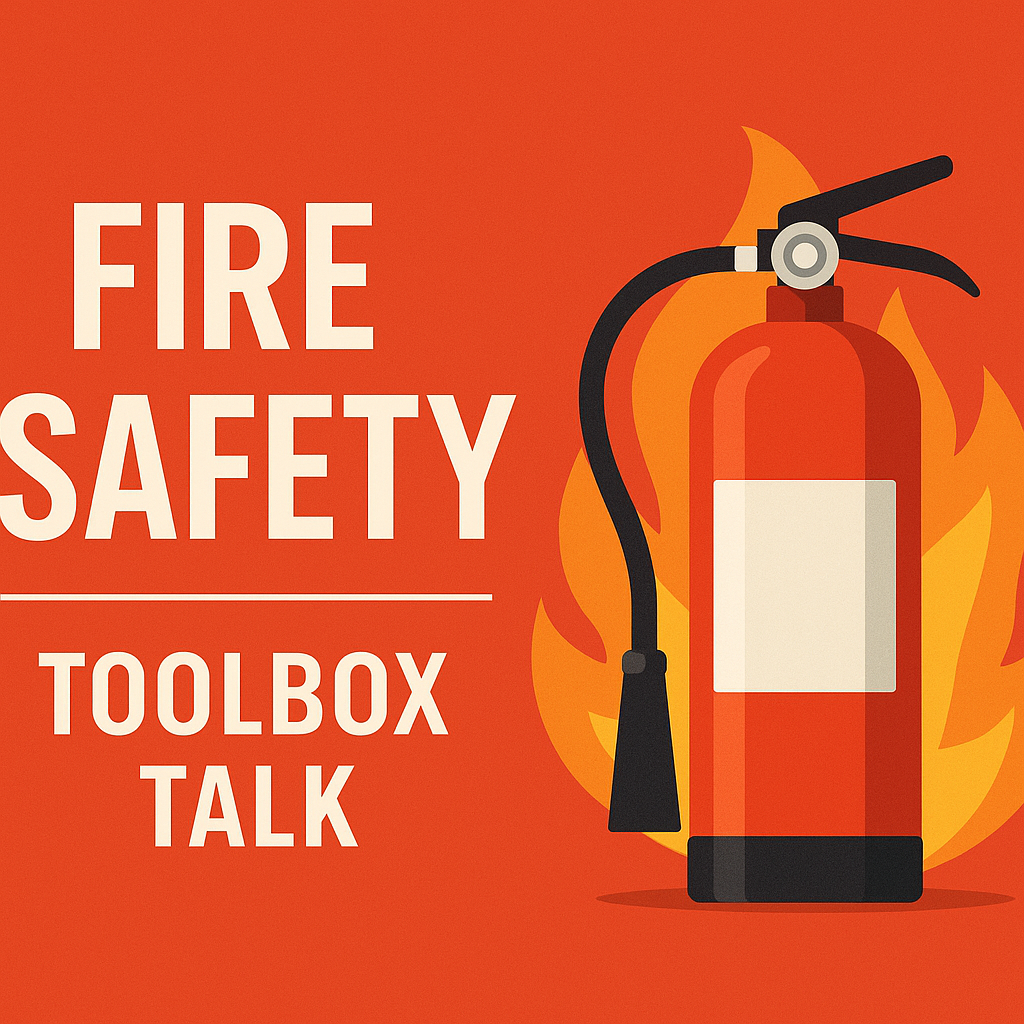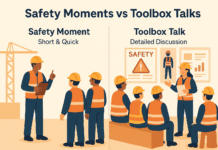
Fire Safety TBT
Good morning team,
Today’s safety talk is about Fire Safety — one of the most important topics in any workplace.
Fire can start in seconds, spread in minutes, and destroy lives, property, and livelihoods. It doesn’t matter if we’re in a construction site, warehouse, plant, or office — if a fire breaks out and we’re not ready, the consequences can be deadly.
The good news? Most workplace fires are preventable. Fires start because three elements come together — heat, fuel, and oxygen — what we call the fire triangle. Remove any one of them, and a fire cannot start or continue.
Today, we’ll cover:
- Why fire safety matters
- Common causes of workplace fires
- The fire triangle
- Fire prevention measures
- Emergency procedures
- Fire extinguisher use
- Do’s and don’ts
- Real-life example
- Closing safety message
1. Why Fire Safety Matters
- Fires can cause severe burns, smoke inhalation injuries, and death.
- Property damage can halt operations and cost millions.
- Fires create chaos — without training, panic can lead to more injuries.
- A fire can double in size every 30 seconds if not controlled.
2. Common Causes of Workplace Fires
- Electrical faults — damaged cables, overloaded circuits, faulty equipment.
- Hot work — welding, grinding, cutting near flammable materials.
- Flammable liquids and gases — poor storage or leaks.
- Smoking in unauthorized areas.
- Poor housekeeping — clutter and waste materials acting as fuel.
- Arson — deliberate ignition.
3. The Fire Triangle
For a fire to start, three things must be present:
- Heat – Sparks, flames, hot surfaces.
- Fuel – Wood, paper, cloth, flammable liquids, gases.
- Oxygen – Usually present in the air.
Removing any one of these stops the fire:
- Remove heat (cooling with water).
- Remove fuel (clearing combustibles).
- Remove oxygen (smothering with foam or CO₂).
4. Fire Prevention Measures
- Regularly inspect and maintain electrical systems.
- Store flammable materials in approved containers.
- Keep ignition sources away from flammable substances.
- Maintain clear escape routes at all times.
- Follow hot work permit procedures.
- Conduct regular fire drills.
5. Emergency Procedures
- Raise the alarm immediately.
- Evacuate using the nearest safe exit.
- Report to the assembly point.
- Only attempt to fight the fire if:
- You are trained.
- The fire is small and contained.
- You have the correct extinguisher.
- You have a clear escape route.
6. Fire Extinguisher Basics
There are different types of fire extinguishers for different classes of fires:
| Type | Use On | Do Not Use On |
|---|---|---|
| Water | Class A – wood, paper, cloth | Electrical or flammable liquid fires |
| Foam | Class A and B – solids and flammable liquids | Electrical fires unless rated safe |
| CO₂ | Electrical fires, flammable liquids | Fires in confined spaces without ventilation |
| Dry Powder | Most fire types including electrical | Confined spaces (can reduce visibility) |
PASS Technique for extinguisher use:
- Pull the pin.
- Aim at the base of the fire.
- Squeeze the handle.
- Sweep from side to side.
7. Do’s and Don’ts
✅ Do:
- Know the location of extinguishers and exits.
- Keep combustibles away from ignition sources.
- Report damaged electrical equipment.
- Take fire drills seriously.
❌ Don’t:
- Block fire exits or extinguishers.
- Use the wrong extinguisher for the fire type.
- Attempt to fight a large or spreading fire.
- Ignore a fire alarm.
8. Real-Life Case Study
In 2020, a small electrical fire started in a warehouse. The alarm was ignored by some workers who thought it was a drill. By the time action was taken, the fire had spread through stored cardboard boxes. No one was injured, but the company lost millions in stock and production downtime.
Lesson: Treat every alarm as real — your reaction in the first minutes matters most.
9. Worker Engagement – Q&A
- What are the three elements of the fire triangle?
- When should you NOT attempt to fight a fire?
- How do you operate a fire extinguisher using PASS?
10. Closing Words – Bringing It Back to the Start
Alright team, we began today by talking about how quickly fire can start and spread. The key to fire safety is prevention first, quick action second.
Every one of us has a role:
- Keep your work area tidy.
- Report hazards immediately.
- Know your escape routes.
- Respect alarms and drills.
If you’re trained and it’s safe, you can tackle a small fire — but your life always comes first.
Remember: property can be replaced — people cannot.
Stay alert, stay safe, and let’s have a productive day.
Manual Material Handling Safety TBT

























I love this course